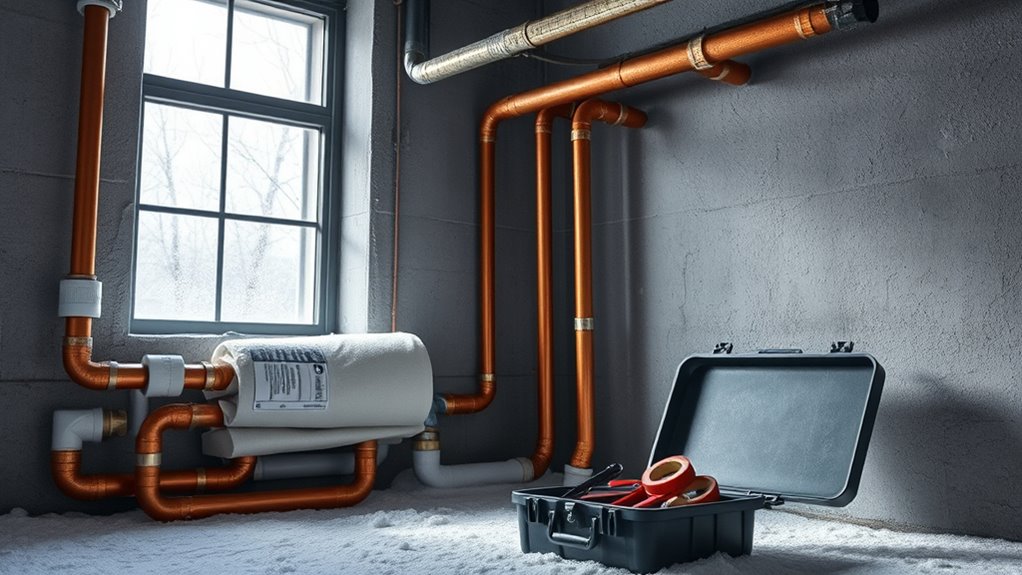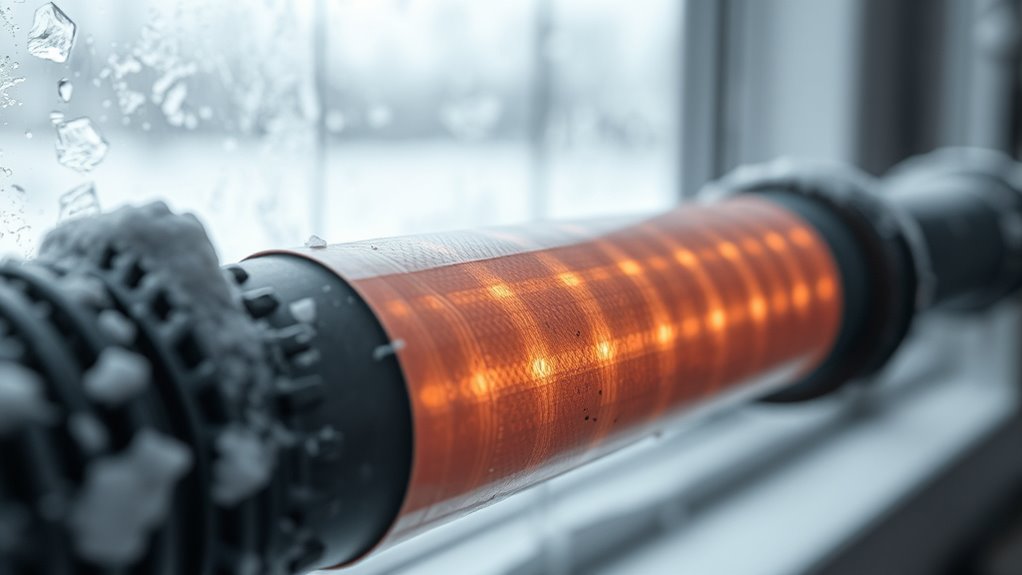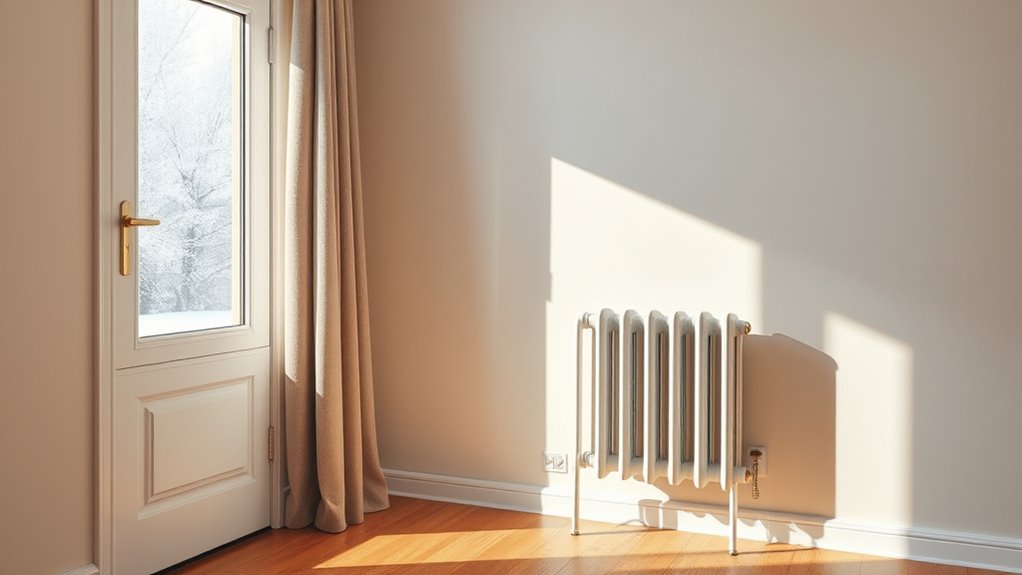To prevent pipes from freezing without power, follow these essential tips:
- Insulate Pipes: Use foam sleeves or wraps on exposed pipes to provide insulation.
- Drip Faucets: Let faucets drip slowly to keep water moving and reduce the risk of freezing.
- Open Cabinet Doors: Keep cabinet doors under sinks open to allow warm air to circulate around pipes.
- Utilize Sunlight: Open curtains during the day to let sunlight warm up your space.
- Space Heaters: If safe, place space heaters near vulnerable pipes for extra warmth.
Implement these strategies to help keep your plumbing functional throughout the winter.
Understanding Pipe Freezing Risks

As winter temperatures drop below 32 degrees Fahrenheit, homeowners face the risk of frozen pipes, which can burst and lead to costly water damage.
This risk is heightened in unheated areas like basements, attics, and garages.
To prevent frozen pipes, be proactive by insulating exposed pipes and monitoring for signs like reduced water flow or unusual sounds.
Early detection is key to avoiding significant repairs.
Taking these precautions can help protect your home from the damaging effects of frozen pipes this winter.
Insulating Exposed Pipes
To prevent your pipes from freezing this winter, insulating exposed pipes is crucial. Use materials like foam pipe sleeves, fiberglass wraps, or heat tape to cover vulnerable pipes in areas such as basements, attics, and crawl spaces.
Pay extra attention to spots with poor heating or drafts, as they are more likely to freeze. Insulating pipes not only protects against freezing but also improves energy efficiency by minimizing heat loss.
Regularly check your insulation to ensure it remains intact and effective throughout the winter.
Dripping Faucets to Prevent Freezing
Dripping faucets can help prevent your pipes from freezing during cold winter months.
By allowing a small stream of water to flow, you can relieve pressure in your plumbing system and reduce the risk of ice formation.
To maximize this preventative measure without wasting water, aim for a drip rate of about one drop per second.
This simple step can protect your home from costly plumbing issues.
Benefits of Dripping Faucets
Dripping faucets can prevent pipes from freezing during cold winter months. By allowing water to flow continuously, the risk of stagnation is reduced, which helps maintain movement within the plumbing system.
This movement makes it less likely for water to freeze, even in extreme temperatures. Additionally, dripping faucets can help relieve pressure that may build up if ice forms inside the pipes.
This simple solution is particularly useful for homeowners in areas with severe cold, providing peace of mind without requiring significant financial investment or resources.
Ideal Faucet Drip Rate
To effectively prevent pipe freezing, it’s crucial to establish the right drip rate for your faucets. Research suggests that a drip rate of 5 to 10 drops per minute is optimal for most homes. This rate effectively maintains water flow while minimizing water waste.
| Drip Rate (Drops/Minute) | Effectiveness | Water Usage |
|---|---|---|
| 0 | Low | None |
| 5 | Moderate | Minimal |
| 10 | High | Moderate |
Utilizing Heat Tape

Heat tape is an effective solution for preventing pipes from freezing during winter.
This guide will cover the different types of heat tape and provide essential installation tips. By following these recommendations, homeowners can protect their plumbing systems from extreme cold.
Types of Heat Tape
To prevent frozen pipes during winter, heat tape is an effective solution.
There are two main types of heat tape: self-regulating and constant wattage.
- Self-Regulating Heat Tape: This type adjusts its heat output based on the surrounding temperature, making it energy-efficient and reducing the risk of overheating.
- Constant Wattage Heat Tape: This type provides a consistent level of heat regardless of temperature changes but requires careful monitoring to prevent overheating.
Choosing the right heat tape depends on your specific needs for pipe protection.
Installation Best Practices
To effectively prevent frozen pipes, proper installation of heat tape is crucial. Here are key best practices to follow:
- Clean the Surface: Ensure that pipes are free from dirt and moisture before applying heat tape for better adhesion.
- Follow Manufacturer Instructions: Adhere to the specific guidelines provided with your heat tape to ensure safety and effectiveness.
- Secure with Tape: Use electrical tape to fasten the heat tape firmly against the pipe, ensuring direct contact.
- Avoid Overlapping: Prevent overheating and damage by not overlapping sections of heat tape.
Keeping Cabinet Doors Open
To prevent pipes from freezing during severe winter weather, it’s essential to keep cabinet doors open, especially those under sinks. This allows warmer air to circulate around the plumbing, maintaining a stable temperature and significantly reducing the risk of pipe bursts and costly repairs.
Benefits of Keeping Cabinet Doors Open:
- Enhances air circulation
- Reduces freezing risk
- Protects vulnerable pipes
- Saves on heating costs
- Simple and effective
Tips for Implementation:
- Open doors during cold spells
- Leave doors open overnight
- Monitor temperature regularly
- Use insulation if necessary
- Combine with other winter-proofing methods
Using Space Heaters Safely
When using space heaters during winter emergencies, ensure proper placement for maximum safety and effectiveness.
Keep heaters at least three feet away from flammable materials, walls, and furniture to prevent fire hazards.
Following these safety guidelines will help you create a safer environment while staying warm.
Heater Placement Tips
To maximize the effectiveness of your space heater during cold weather, proper placement is crucial.
Here are key tips for optimal heater positioning:
- Close to Vulnerable Areas: Place heaters near exterior walls, particularly where pipes are at risk of freezing.
- Ensure Open Space: Position heaters in unobstructed areas to facilitate effective heat circulation.
- Keep Clear of Clutter: Maintain a clear space around the heater to prevent any blockage of heat.
- Centralized Location: Whenever possible, position heaters centrally to distribute warmth evenly throughout the room, ensuring all pipes receive adequate heat.
Safety Precautions Needed
Using space heaters safely is crucial to prevent fire hazards. Here are essential safety tips:
- Clear Space: Maintain a minimum distance around the heater, keeping it away from flammable materials like curtains and furniture.
- Stable Surface: Always place the heater on a flat, stable surface to avoid tipping.
- Automatic Shut-Off: Choose models with automatic shut-off features for added safety.
- Never Leave Unattended: Do not leave the heater running while you’re sleeping or away.
- Monitor Temperature: Use a thermostat to keep track of room temperature and prevent overheating.
- Inspect Cords: Regularly check the electrical cords for damage; avoid using heaters with frayed wires.
Following these precautions will help ensure a safe environment when using space heaters.
Creating a Barrier With Blankets
To effectively insulate exposed pipes during winter and prevent freezing, follow these steps:
- Gather blankets: Use old or thick blankets for better insulation.
- Identify exposed pipes: Focus on pipes in unheated areas like basements or crawl spaces.
- Wrap the pipes: Drape the blankets fully around the pipes, ensuring no gaps.
- Secure the blankets: Use duct tape or rope to keep the blankets in place.
This method is simple and helps protect your plumbing from harsh winter conditions.
Maintaining a Consistent Temperature
To prevent your pipes from freezing during winter, it’s crucial to maintain a consistent temperature in areas where they are located.
Here are some effective strategies:
- Use Alternative Heating: Consider space heaters or wood stoves to warm critical areas.
- Open Cabinet Doors: This allows warm air to circulate around plumbing fixtures, reducing the risk of freezing.
- Keep Interior Doors Open: This helps maintain an even temperature throughout your home.
- Drip Faucets: Allowing faucets to drip slightly can prevent freezing by keeping water flowing.
- Monitor Indoor Temperature: Regularly check that the temperature stays above freezing to protect your pipes.
Implementing these steps can significantly reduce the risk of pipe damage during extreme cold.
Identifying Vulnerable Areas
As temperatures drop, homeowners need to be aware of areas in their property that are prone to pipe freezing.
Here are the key vulnerable zones to inspect:
- Unheated Basements – These spaces can cool rapidly due to a lack of insulation.
- Crawl Spaces – Pipes in these areas are directly exposed to cold air.
- Exterior Walls – Insufficient insulation can lead to freezing in pipes along outside walls.
- Attics – Poor insulation in attics can expose pipes to frigid temperatures.
Closing Off Unused Rooms

To prevent pipes from freezing in winter, sealing off unused rooms is a smart strategy.
Close vents and insulate doorways to keep warmth in living areas.
This simple action helps reduce the risk of pipe damage during cold weather, ensuring your home remains safe and functional.
Seal Off Vents
How to Seal Off Vents in Unused Rooms for Winter Energy Efficiency
Sealing off vents in unused rooms can improve your home’s energy efficiency during winter. Here’s how to do it effectively:
- Identify Unused Rooms: Find rooms that are rarely used and can be sealed off.
- Close Vent Covers: Shut the vents in these rooms to prevent warm air from escaping.
- Block Airflow: Use magnetic or insulated vent covers to minimize air transfer.
- Monitor Temperatures: Check temperatures in these areas to ensure they stay above freezing.
Insulate Doorways Effectively
Insulating doorways is a practical way to keep warmth in unused rooms during winter. To effectively block cold air and reduce heating costs, consider these simple strategies:
- Draft Stoppers or Door Sweeps: Place these at the base of doors to seal gaps and prevent chilly drafts.
- Heavy Curtains or Blankets: Hang them over doorways to add an extra layer of insulation, helping to trap warm air.
- Door Insulation Kits: For a more permanent solution, install these kits to enhance insulation.
Implementing these measures not only preserves heat but also creates a more comfortable living environment.
Additionally, it helps protect plumbing from freezing damage during extreme cold.
Adding Extra Insulation
When temperatures drop, it’s crucial to insulate exposed pipes to prevent freezing.
Here are effective ways to enhance your pipe insulation:
- Foam Pipe Insulation: Fit foam sleeves around pipes for easy and effective insulation.
- Heat Tape: Use electric heat tape to provide direct warmth to vulnerable pipes.
- Insulated Blankets: Wrap pipes in insulated blankets or towels, especially in unheated areas.
- Seal Gaps: Close any gaps in walls and foundations to block cold air from entering.
These steps will help protect your pipes and reduce the risk of freezing during cold spells.
Utilizing Sunlight for Heat
Preventing frozen pipes during winter is crucial for homeowners. Here are effective strategies to utilize sunlight for heat:
- Open Curtains and Blinds: Allow natural light to warm your interior spaces during the day.
- Use Mirrors: Strategically place mirrors to reflect sunlight into darker areas, warming locations where pipes are located.
- Create Mini-Greenhouses: Apply clear plastic sheeting around windows to trap heat and raise indoor temperatures.
- Keep Unheated Doors Closed: This helps concentrate warmth in areas with plumbing.
Water Flow Techniques
To prevent pipes from freezing during cold winter months, it’s essential to keep water flowing. Here are effective techniques you can implement:
- Drip Faucets: Letting faucets drip keeps water moving and prevents it from freezing.
- Open Cabinet Doors: Open the doors under sinks to allow warm air to circulate around the pipes.
- Run Water: Keep a trickle of water running in vulnerable pipes to ensure constant movement.
- Use Multiple Fixtures: Turn on various fixtures in your home to promote overall water circulation.
Emergency Heating Alternatives
In the event of a sudden cold snap that threatens your pipes, there are several effective emergency heating alternatives to consider:
- Space Heaters: Position space heaters near vulnerable areas like basements and crawl spaces to provide immediate warmth and protect your pipes from freezing.
- Hot Water Bottles and Heating Pads: Utilize hot water bottles or heating pads to wrap around at-risk pipes, offering localized heat where it’s needed most.
- Fireplace or Wood Stove: If you have access to a fireplace or wood stove, keeping a fire burning can help warm adjacent areas, further protecting your plumbing.
- Open Cabinet Doors: Allow warm air to circulate by opening cabinet doors under sinks, which can help prevent pipes from freezing in those enclosed spaces.
Preparing for Future Winters
As winter nears, it’s crucial for homeowners to prepare their plumbing systems to prevent frozen pipes and expensive repairs.
Here are key steps to take:
- Insulate Pipes: Apply foam insulation or pipe sleeves to exposed pipes, particularly those in unheated spaces.
- Seal Gaps: Inspect windows, doors, and foundations for air leaks and seal any gaps to block cold drafts.
- Maintain Heating: Keep your thermostat at a steady temperature, even when you’re not home, to ensure pipes stay warm.
- Drain Outdoor Faucets: Remove hoses and drain outdoor faucets to prevent water from freezing in the pipes.
Following these steps will help you safeguard your plumbing this winter.
Conclusion
As winter approaches, homeowners need effective strategies to prevent pipes from freezing, especially during power outages. Here are practical measures to protect your plumbing:
- Insulate Pipes: Use foam pipe insulation or wrap pipes with towels to keep them warm, particularly those in unheated areas.
- Seal Drafts: Close gaps around windows and doors to minimize cold air infiltration and keep indoor temperatures stable.
- Let Faucets Drip: Allow a small stream of water to flow from faucets during extreme cold to reduce pressure and prevent freezing.
- Open Cabinet Doors: Open kitchen and bathroom cabinets to allow warm air to circulate around plumbing.
- Use Space Heaters: If safe, use space heaters in areas with vulnerable pipes, ensuring proper ventilation and safety precautions.
- Keep the Thermostat Consistent: Maintain a stable temperature, even at night, to prevent sudden drops that can lead to freezing.
By implementing these strategies, you can significantly reduce the risk of frozen pipes and protect your home this winter.

I’m Allen Kim, the chief editor of plumbinginto. I am a mid level plumber and assign to an local firm over 4 years of experience. During the working period, most of my experience is related to the house plumbing. I learned about the thing, when working with most experienced people in this sector, one must be as good as the inspector or better with knowledge of the project as well as the practical aspects of plumbing industry.